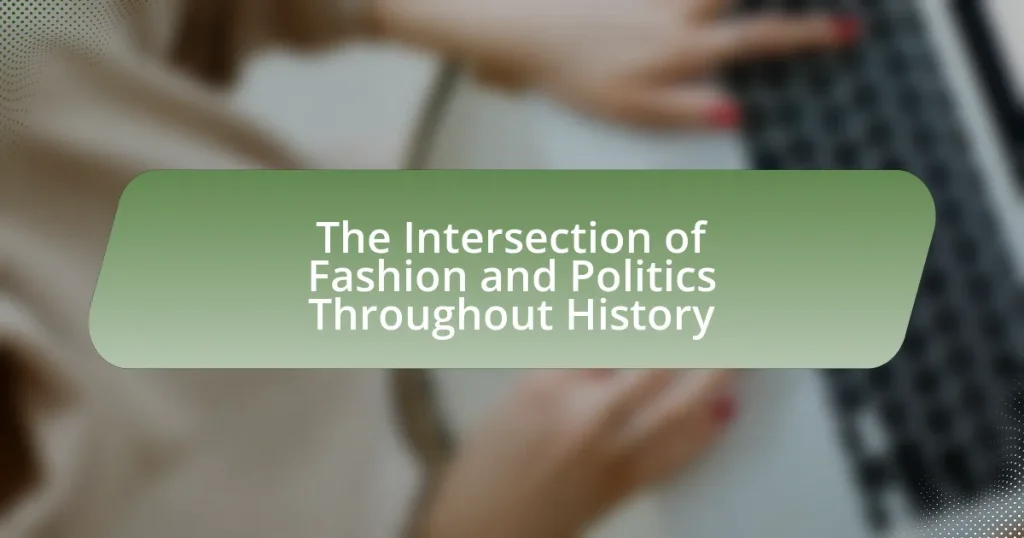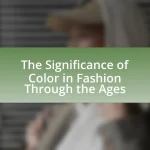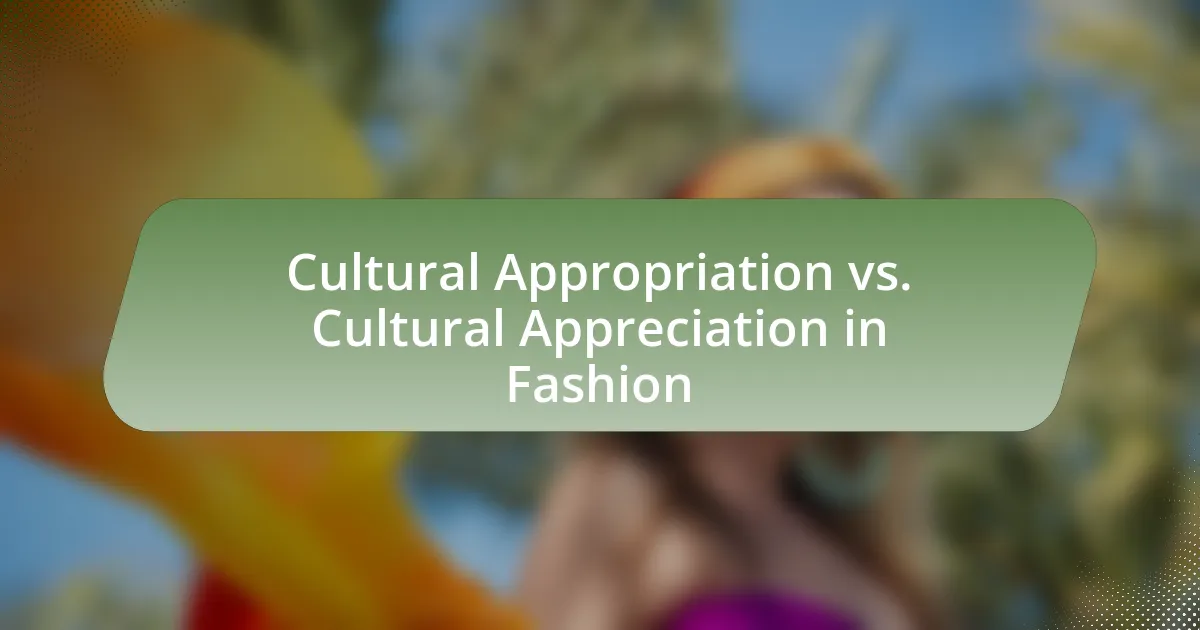The article examines the historical intersection of fashion and politics, highlighting how clothing has been utilized as a means of political expression and social mobilization across various eras. Key examples include the adoption of trousers by the sans-culottes during the French Revolution, the use of distinctive attire by the Black Panther Party, and the fashion choices of suffragettes advocating for women’s rights. The article also explores how political leaders use fashion to convey messages and the implications of cultural appropriation in fashion politics. Additionally, it discusses contemporary issues such as sustainability and activism, emphasizing the evolving relationship between fashion and political ideologies in today’s society.
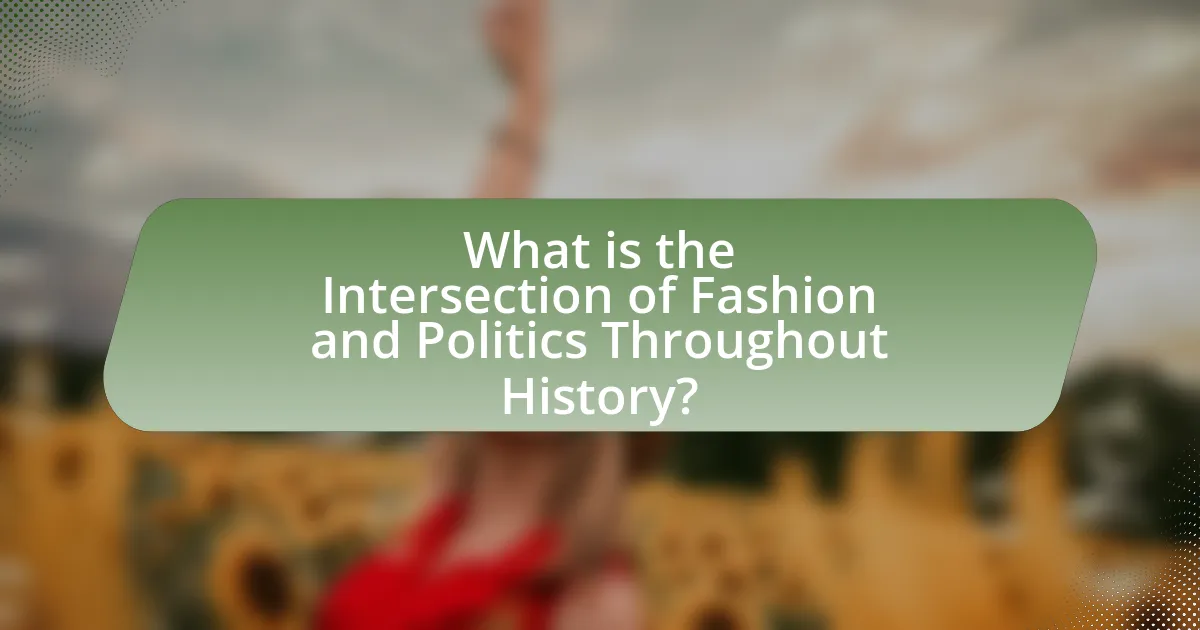
What is the Intersection of Fashion and Politics Throughout History?
The intersection of fashion and politics throughout history is characterized by the use of clothing as a means of expressing political identity and social movements. For example, during the French Revolution, the sans-culottes adopted trousers instead of knee breeches to symbolize their rejection of aristocratic privilege. Similarly, in the 1960s, the counterculture movement utilized fashion, such as tie-dye shirts and bell-bottoms, to challenge societal norms and promote anti-establishment sentiments. These instances illustrate how fashion has served as a powerful tool for political expression and social change, reflecting broader cultural shifts and ideologies.
How has fashion been used as a political tool in different eras?
Fashion has been used as a political tool throughout history to express ideologies, challenge authority, and mobilize social movements. For instance, during the French Revolution, the sans-culottes adopted working-class attire to symbolize their rejection of aristocratic fashion and assert their political identity. In the 1960s, countercultural movements utilized clothing, such as bell-bottoms and tie-dye shirts, to protest against the Vietnam War and promote peace and love. Additionally, the Black Panther Party in the 1960s used their distinctive uniforms to convey solidarity and assert their political stance against racial oppression. These examples illustrate how fashion has served as a medium for political expression and social change across different eras.
What are some historical examples of fashion influencing political movements?
Fashion has historically influenced political movements through symbolic attire and collective identity. For instance, the suffragette movement in the early 20th century utilized white dresses and purple and green sashes to symbolize purity and the fight for women’s rights, effectively uniting women under a recognizable visual identity. Similarly, the Black Panther Party in the 1960s adopted a uniform of black berets, leather jackets, and sunglasses, which not only conveyed solidarity but also challenged racial stereotypes and asserted their political stance against oppression. Additionally, the French Revolution saw the adoption of the sans-culottes, who wore long trousers instead of the aristocratic knee breeches, symbolizing a rejection of the elite and a push for egalitarianism. These examples illustrate how fashion serves as a powerful tool for political expression and mobilization.
How do political leaders utilize fashion to convey messages?
Political leaders utilize fashion to convey messages by strategically selecting clothing that reflects their values, ideologies, and political agendas. For instance, during the 1960s, John F. Kennedy’s tailored suits symbolized modernity and professionalism, aligning with his vision of a progressive America. Similarly, Angela Merkel often wore simple, practical outfits that emphasized her no-nonsense leadership style, reinforcing her image as a pragmatic and reliable leader. These choices are not merely aesthetic; they serve to communicate authority, relatability, and cultural identity, influencing public perception and political narratives.
Why is the relationship between fashion and politics significant?
The relationship between fashion and politics is significant because fashion serves as a powerful medium for political expression and social commentary. Throughout history, clothing has been used to convey political ideologies, challenge societal norms, and mobilize movements. For instance, the suffragette movement in the early 20th century utilized specific styles, such as white dresses and sashes, to symbolize their fight for women’s rights. Additionally, during the 1960s, the counterculture movement adopted distinct fashion choices, like bell-bottoms and tie-dye, to protest against the Vietnam War and advocate for peace. These examples illustrate how fashion not only reflects political climates but also actively participates in shaping them, making the relationship between the two a crucial aspect of cultural history.
What impact does fashion have on public perception of political figures?
Fashion significantly influences public perception of political figures by shaping their image and conveying messages about their values and authority. For instance, when political leaders adopt specific styles, such as formal attire or casual wear, it can evoke trust, relatability, or elitism among the public. Historical examples include John F. Kennedy’s tailored suits, which projected a modern and confident image during the 1960 presidential campaign, contrasting with Richard Nixon’s less polished appearance, which contributed to perceptions of untrustworthiness in the 1960 debates. Additionally, fashion choices can signal alignment with social movements; for example, Alexandria Ocasio-Cortez’s use of affordable fashion brands has resonated with younger voters, emphasizing accessibility and relatability. Thus, fashion serves as a powerful tool in shaping the narrative surrounding political figures and their connection to the electorate.
How does fashion reflect societal values and political climates?
Fashion reflects societal values and political climates by serving as a visual representation of cultural norms, beliefs, and political ideologies. For instance, during the 1960s, the rise of counterculture movements in the United States was mirrored in fashion trends such as bell-bottom jeans and tie-dye shirts, which symbolized rebellion against traditional values and authority. Additionally, the adoption of specific styles, like the black beret worn by the Black Panther Party, conveyed political solidarity and resistance. Historical events, such as the French Revolution, also influenced fashion; the shift from opulent clothing to simpler styles represented a rejection of aristocratic values and a move towards egalitarianism. Thus, fashion acts as a barometer for societal change, reflecting the prevailing attitudes and political sentiments of its time.
In what ways has fashion evolved in response to political changes?
Fashion has evolved significantly in response to political changes by reflecting societal values, ideologies, and movements. For instance, during the French Revolution, the shift from aristocratic styles to simpler, more practical clothing symbolized a rejection of the monarchy and the embrace of egalitarian ideals. Similarly, the suffragette movement in the early 20th century saw women adopting more practical attire, such as trousers, to assert their independence and challenge traditional gender roles. The rise of punk fashion in the 1970s was a direct response to political discontent, using clothing as a form of protest against authority and mainstream culture. These examples illustrate how fashion serves as a barometer for political sentiment, adapting to reflect the changing landscape of power and social justice.
What role did fashion play during major political revolutions?
Fashion served as a powerful tool for expression and identity during major political revolutions. It allowed individuals and groups to visually communicate their political beliefs, social status, and solidarity with revolutionary movements. For instance, during the French Revolution, the adoption of simpler clothing styles, such as the sans-culottes’ trousers, symbolized a rejection of aristocratic fashion and a push for egalitarianism. Similarly, in the Russian Revolution, the Bolsheviks promoted utilitarian clothing to reflect their ideology of class struggle and to distance themselves from the opulence of the Tsarist regime. These examples illustrate how fashion not only reflected societal changes but also actively participated in shaping political narratives and mobilizing support for revolutionary causes.
How have fashion trends mirrored shifts in political ideologies?
Fashion trends have reflected shifts in political ideologies by serving as visual representations of societal values and movements. For instance, during the 1960s, the counterculture movement embraced styles like bell-bottoms and tie-dye, symbolizing rebellion against traditional norms and authority, which aligned with anti-establishment sentiments. Similarly, the rise of power dressing in the 1980s, characterized by bold shoulder pads and tailored suits, mirrored the increasing presence of women in the workforce and the feminist movement advocating for gender equality. Historical events, such as the French Revolution, also influenced fashion; the adoption of simpler, more practical clothing by revolutionaries signified a rejection of aristocratic excess and a push for egalitarianism. These examples illustrate how fashion not only reflects but also actively participates in the dialogue surrounding political ideologies.
How do contemporary issues shape the intersection of fashion and politics?
Contemporary issues significantly shape the intersection of fashion and politics by influencing public discourse and identity representation. For instance, movements such as Black Lives Matter and climate activism have prompted designers and brands to adopt socially conscious practices, reflecting societal values and political stances. The 2020 Met Gala, themed “About Time: Fashion and Duration,” showcased designers who incorporated messages of sustainability and inclusivity, highlighting how fashion can serve as a platform for political expression. Additionally, the rise of social media has amplified the visibility of fashion as a tool for political statements, with influencers and activists using their platforms to advocate for change, thereby intertwining fashion choices with political ideologies.
What are the implications of fashion activism in today’s political landscape?
Fashion activism significantly influences today’s political landscape by serving as a platform for social change and raising awareness about critical issues. This form of activism allows individuals and brands to express political beliefs through clothing, thereby engaging audiences in conversations about topics such as climate change, gender equality, and racial justice. For instance, the rise of sustainable fashion movements highlights the environmental impact of the fashion industry, prompting consumers to consider ethical consumption. Additionally, high-profile events, such as the Met Gala, have seen celebrities use their fashion choices to advocate for political causes, amplifying their messages to a global audience. This intersection of fashion and politics not only shapes public discourse but also mobilizes communities, as seen in campaigns like “Black Lives Matter,” where fashion has been used to promote solidarity and awareness.
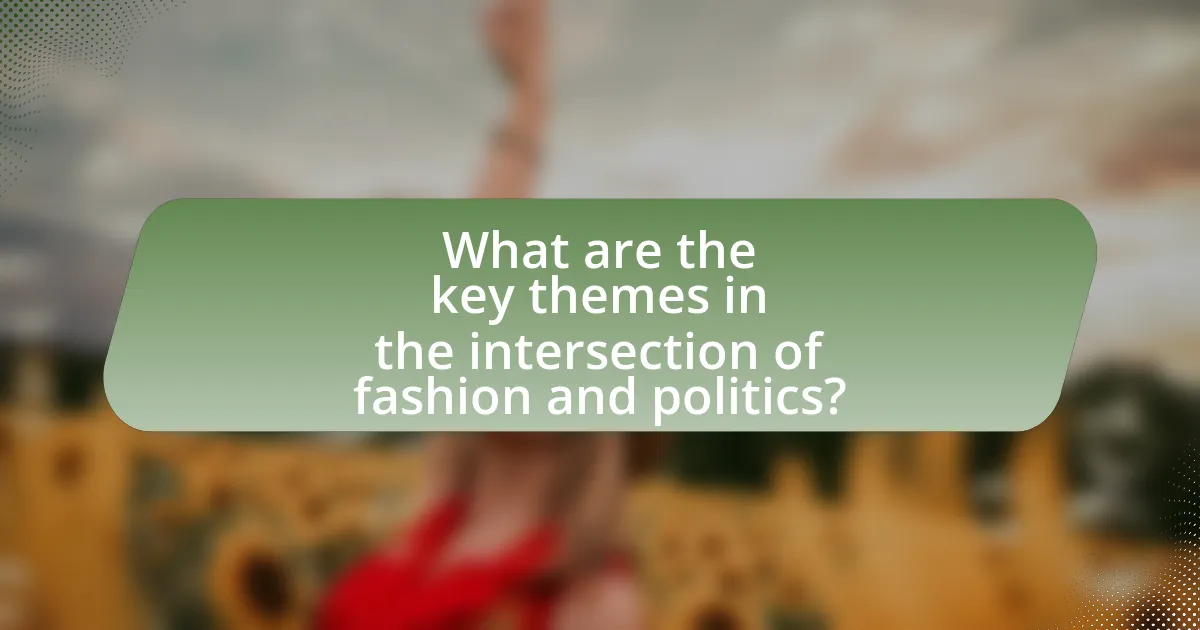
What are the key themes in the intersection of fashion and politics?
The key themes in the intersection of fashion and politics include identity, power dynamics, social movements, and cultural representation. Fashion serves as a medium for individuals and groups to express their political beliefs and social identities, often reflecting or challenging societal norms. For instance, the suffragette movement in the early 20th century utilized fashion to symbolize women’s rights, with the adoption of white dresses as a statement of purity and equality. Additionally, fashion can reinforce or subvert power structures, as seen in the use of military uniforms to convey authority or the adoption of streetwear by marginalized communities to assert cultural identity. Historical examples, such as the use of clothing during the Civil Rights Movement, illustrate how fashion can mobilize social change and foster solidarity among activists.
How does gender influence the political significance of fashion?
Gender significantly influences the political significance of fashion by shaping societal norms and expectations regarding appearance and identity. Historically, women’s fashion has often been a site of political expression, as seen in movements like suffragism, where clothing choices symbolized resistance against patriarchal norms. For instance, the adoption of trousers by women in the early 20th century challenged traditional gender roles and was a statement for equality. Conversely, men’s fashion has also played a role in political identity, with styles such as military uniforms symbolizing power and authority. The political implications of fashion are further evidenced by the 2017 Women’s March, where the pink “pussyhat” became a symbol of protest against gender inequality and political oppression. Thus, gender not only dictates personal style but also serves as a powerful medium for political expression and social change.
What are the historical contexts of women’s fashion in political movements?
Women’s fashion has historically played a significant role in political movements, serving as a form of expression and resistance. For instance, during the suffragette movement in the early 20th century, women adopted white dresses and sashes to symbolize purity and the fight for voting rights, which was a direct challenge to societal norms. Similarly, in the 1960s, the feminist movement embraced clothing that rejected traditional femininity, such as pants and androgynous styles, to promote gender equality and women’s liberation. The Black Panther Party in the 1960s also utilized fashion, with members wearing black berets and leather jackets to convey strength and solidarity in their fight against racial injustice. These examples illustrate how women’s fashion has been intertwined with political activism, reflecting broader social changes and movements throughout history.
How do men’s fashion choices reflect political affiliations?
Men’s fashion choices often reflect political affiliations through the symbolism and messaging embedded in their attire. For instance, specific clothing items, colors, and styles can signify allegiance to particular political movements or ideologies. Historical examples include the adoption of military-style clothing by various political groups, such as the use of khaki by the British Army, which later became associated with nationalism and conservatism. Additionally, during the 1960s, counterculture movements embraced denim and tie-dye as symbols of rebellion against the establishment, aligning their fashion with anti-establishment sentiments. Research indicates that clothing can serve as a non-verbal form of political expression, with studies showing that individuals often choose attire that aligns with their political beliefs to signal their identity to others.
What role does cultural appropriation play in fashion politics?
Cultural appropriation plays a significant role in fashion politics by highlighting power dynamics and issues of representation within the industry. It often involves the adoption of elements from marginalized cultures by dominant cultures, leading to debates about exploitation versus appreciation. For instance, the use of traditional garments, symbols, or styles without proper acknowledgment or respect can perpetuate stereotypes and commodify cultural identities. This dynamic has been evident in various instances, such as the backlash against high-profile brands that have faced criticism for using Indigenous designs without permission, illustrating the ongoing tensions between cultural respect and commercial interests.
How can cultural appropriation in fashion impact political discourse?
Cultural appropriation in fashion can significantly impact political discourse by highlighting issues of power dynamics, identity, and representation. When designers use elements from marginalized cultures without permission or understanding, it often leads to public backlash and discussions about exploitation and respect. For instance, the 2015 backlash against a high-fashion brand for using Native American headdresses in a runway show sparked debates about cultural sensitivity and the commodification of indigenous identities. This incident illustrates how fashion choices can provoke broader conversations about social justice, equity, and the need for cultural respect, thereby influencing political narratives and activism surrounding these issues.
What are the consequences of misrepresenting cultural fashion in politics?
Misrepresenting cultural fashion in politics can lead to significant social backlash and cultural appropriation accusations. When political figures adopt or misinterpret cultural attire, it often results in alienation of the communities they represent, as seen in instances where politicians have faced criticism for wearing traditional garments without understanding their significance. For example, in 2018, a U.S. politician was criticized for donning a Native American headdress during a public event, which many viewed as disrespectful and trivializing to Indigenous cultures. Such actions can undermine trust between political leaders and marginalized communities, leading to decreased political engagement and increased tensions.
How does globalization affect the relationship between fashion and politics?
Globalization significantly influences the relationship between fashion and politics by facilitating the exchange of cultural symbols and political ideologies across borders. This interconnectedness allows fashion to serve as a medium for political expression, where designers and brands can convey messages related to social movements, identity, and resistance. For instance, the rise of fast fashion has sparked political debates regarding labor rights and environmental sustainability, as seen in campaigns like Fashion Revolution, which advocates for transparency in the fashion supply chain. Additionally, global events, such as the Women’s March, have seen the use of fashion items like “pussy hats” as symbols of political solidarity, illustrating how globalization enables localized fashion trends to gain international political significance.
What are the political implications of fast fashion on global economies?
Fast fashion significantly influences global economies by perpetuating labor exploitation and impacting trade policies. The industry’s reliance on low-cost labor in developing countries often leads to poor working conditions and inadequate wages, which can incite political unrest and calls for reform. For instance, the 2013 Rana Plaza collapse in Bangladesh, which killed over 1,100 workers, highlighted the dire need for regulatory changes and prompted international scrutiny of labor practices in the fashion sector. Additionally, fast fashion’s environmental degradation can lead to political pressure for stricter environmental regulations, as countries grapple with the consequences of pollution and waste. This interplay between economic practices and political responses illustrates how fast fashion shapes not only market dynamics but also governance and social justice movements globally.
How do international fashion trends influence local political movements?
International fashion trends influence local political movements by shaping cultural identity and social norms, which can mobilize public sentiment and activism. For instance, the adoption of punk fashion in the 1970s not only represented a rebellion against mainstream culture but also aligned with anti-establishment sentiments, leading to increased political engagement among youth in various countries. Additionally, the use of fashion as a form of protest, such as the pink hats worn during the Women’s March in 2017, illustrates how global fashion trends can unify local movements around shared causes. This connection between fashion and political expression is further evidenced by the rise of sustainable fashion, which has prompted local movements advocating for environmental policies and social justice, reflecting a broader global awareness of these issues.

What are the future trends in the intersection of fashion and politics?
Future trends in the intersection of fashion and politics will increasingly focus on sustainability, inclusivity, and activism. As consumers become more socially conscious, fashion brands are likely to adopt eco-friendly practices and materials, reflecting a growing demand for environmental responsibility. Additionally, the rise of social movements will push brands to embrace diversity and representation, leading to more inclusive designs and marketing strategies. Activism in fashion will manifest through collaborations with political causes, where designers use their platforms to advocate for social justice, human rights, and political change. This trend is supported by the increasing visibility of fashion in political discourse, as seen in events like the Met Gala, where themes often reflect current social issues.
How might technology reshape the political landscape of fashion?
Technology will reshape the political landscape of fashion by enabling greater transparency and democratization of information. Digital platforms allow consumers to access information about the ethical practices of brands, influencing purchasing decisions and pressuring companies to adopt sustainable practices. For instance, blockchain technology can track the supply chain of garments, providing verifiable data on labor conditions and environmental impact. This shift empowers consumers to hold brands accountable, as seen in movements like Fashion Revolution, which advocates for transparency in the fashion industry. Additionally, social media amplifies political messages related to fashion, allowing activists to mobilize support for causes such as fair labor rights and environmental sustainability, thereby intertwining fashion with political activism.
What role do social media platforms play in fashion activism?
Social media platforms serve as crucial tools for fashion activism by enabling widespread awareness and engagement around social and political issues related to the fashion industry. These platforms facilitate the rapid dissemination of information, allowing activists to share campaigns, promote sustainable practices, and highlight unethical labor conditions in real-time. For instance, the #WhoMadeMyClothes campaign on Instagram and Twitter has mobilized consumers to question the origins of their clothing, leading to increased transparency and accountability among brands. Additionally, social media allows marginalized voices to be amplified, fostering a diverse dialogue about inclusivity and representation in fashion. The ability to reach global audiences instantly has transformed how fashion activism is organized and executed, making it a powerful force for change.
How can digital fashion influence political expression?
Digital fashion can influence political expression by providing a platform for individuals to showcase their beliefs and identities through virtual clothing and accessories. This medium allows for the rapid dissemination of political messages, as seen in movements like Black Lives Matter, where digital fashion items featuring slogans or symbols can be shared widely on social media. Additionally, digital fashion enables designers to create politically charged garments that can be worn in virtual spaces, amplifying their reach beyond physical limitations. The rise of NFTs in fashion also allows for ownership and trade of politically themed digital items, further embedding political messages in contemporary culture.
What strategies can individuals use to engage with fashion politics?
Individuals can engage with fashion politics by advocating for sustainable and ethical fashion practices. This can be achieved through supporting brands that prioritize fair labor practices, environmentally friendly materials, and transparency in their supply chains. For instance, the Fashion Revolution movement encourages consumers to ask brands “Who made my clothes?” to promote accountability and ethical production. Additionally, individuals can participate in campaigns that raise awareness about the social and environmental impacts of fast fashion, such as the #WhoMadeMyClothes campaign, which highlights the importance of ethical sourcing and labor rights. Engaging in discussions on social media platforms about fashion’s role in societal issues also amplifies voices advocating for change, as seen in the rise of influencers who focus on sustainable fashion.
How can consumers make informed choices about politically charged fashion?
Consumers can make informed choices about politically charged fashion by researching the brands’ values, supply chain practices, and political affiliations. Understanding a brand’s commitment to social issues, such as sustainability or labor rights, can guide consumers in aligning their purchases with their personal beliefs. For instance, brands like Patagonia actively promote environmental activism and transparency in their production processes, which can be verified through their published reports and initiatives. Additionally, consumers can utilize resources like the Fashion Transparency Index, which evaluates brands based on their supply chain transparency, helping them make choices that reflect their political and ethical values.
What are effective ways to advocate for change through fashion?
Effective ways to advocate for change through fashion include using clothing as a medium for social messages, promoting sustainable practices, and collaborating with activists. Clothing can serve as a canvas for slogans and symbols that raise awareness about social issues, as seen in the use of T-shirts during protests, which historically have communicated messages of solidarity and resistance. Additionally, the fashion industry can advocate for environmental change by adopting sustainable practices, as evidenced by brands like Stella McCartney, which prioritize eco-friendly materials and ethical production methods. Collaborations between fashion designers and social movements, such as the partnership between the brand Pyer Moss and the Black Lives Matter movement, further amplify advocacy efforts by merging creative expression with activism, thereby reaching wider audiences and fostering dialogue around critical issues.
